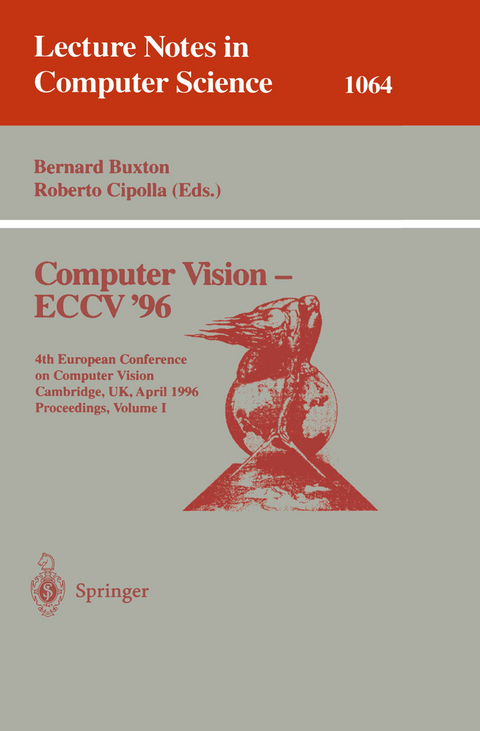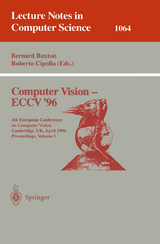Computer Vision - ECCV '96
Springer Berlin (Verlag)
978-3-540-61122-6 (ISBN)
The papers in volume I are grouped in sections on structure from motion; recognition; geometry and stereo; texture and features; tracking; grouping and segmentation; stereo; and recognition, matching, and segmentation.
Self-calibration from image triplets.- Parallax geometry of pairs of points for 3D scene analysis.- Euclidean 3D reconstruction from image sequences with variable focal lengths.- Eigenfaces vs. Fisherfaces: Recognition using class specific linear projection.- Rapid object indexing and recognition using enhanced geometric hashing.- Recognition of geons by parametric deformable contour models.- Automatic extraction of generic house roofs from high resolution aerial imagery.- Three dimensional object modeling via minimal surfaces.- Class based reconstruction techniques using singular apparent contours.- Reliable surface reconstruction from multiple range images.- Shape from appearance: A statistical approach to surface shape estimation.- Volumic segmentation using hierarchical representation and triangulated surface.- Oriented projective geometry for computer vision.- Fast computation of the fundamental matrix for an active stereo vision system.- On binocularly viewed occlusion junctions.- Understanding the shape properties of trihedral polyhedra.- Nonlinear scale-space from n-dimensional sieves.- Hierarchical curve reconstruction. Part I: Bifurcation analysis and recovery of smooth curves.- Texture feature coding method for classification of liver sonography.- Local appropriate scale in morphological scale-space.- Scale-space with casual time direction.- Tracing crease curves by solving a system of differential equations.- Flows under min/max curvature flow and mean curvature: Applications in image processing.- Decomposition of the Hough transform: Curve detection with efficient error propagation.- Image retrieval using scale-space matching.- Optimal surface smoothing as filter design.- Segmentation in dynamic image sequences by isolation of coherent wave profiles.- Texture segmentation using local energy in wavelet scale space.- Tracking medical 3D data with a deformable parametric model.- EigenTracking: Robust matching and tracking of articulated objects using a view-based representation.- Contour tracking by stochastic propagation of conditional density.- Learning dynamics of complex motions from image sequences.- Quantitative analysis of grouping processes.- Geometric saliency of curve correspondences and grouping of symmetric contours.- Computing contour closure.- Visual organization of illusory surfaces.- Uncalibrated relief reconstruction and model alignment from binocular disparities.- Dense depth map reconstruction: A minimization and regularization approach which preserves discontinuities.- Stereo without search.- Informative views and sequential recognition.- Unsupervised texture segmentation using selectionist relaxation.- Robust affine structure matching for 3D object recognition.- Automatic face recognition: What representation?.- Genetic search for structural matching.- Automatic selection of reference views for image-based scene representations.- Object recognition using subspace methods.- Detecting, localizing and grouping repeatedscene elements from an image.- Image recognition with occlusions.- Silhouette-based object recognition with occlusion through curvature scale space.- A focused target segmentation paradigm.- Generalized image matching: Statistical learning of physically-based deformations.- Reasoning about occlusions during hypothesis verification.- Object recognition using multidimensional receptive field histograms.- Normalization by optimization.- Extracting curvilinear structures: A differential geometric approach.- Affine / photometric invariants for planar intensity patterns.- Image synthesis from a single example image.- Complexity of indexing: Efficient and learnable large database indexing.- Spatiotemporal representations for visual navigation.- Decoupling the 3D motion space by fixation.- Automatic singularity test for motion analysis by an information criterion.- Shape ambiguities in structure from motion.
| Erscheint lt. Verlag | 4.4.1996 |
|---|---|
| Reihe/Serie | Lecture Notes in Computer Science |
| Zusatzinfo | XXII, 730 p. |
| Verlagsort | Berlin |
| Sprache | englisch |
| Maße | 155 x 235 mm |
| Gewicht | 1126 g |
| Themenwelt | Informatik ► Grafik / Design ► Digitale Bildverarbeitung |
| Schlagworte | Bildverarbeitung • computer vision • Computervision • Image Processing • Mustererkennung • pattern recognition • Segmentation • Segmentierung • Stereo Vision • Stereo-Vision • Text |
| ISBN-10 | 3-540-61122-3 / 3540611223 |
| ISBN-13 | 978-3-540-61122-6 / 9783540611226 |
| Zustand | Neuware |
| Informationen gemäß Produktsicherheitsverordnung (GPSR) | |
| Haben Sie eine Frage zum Produkt? |
aus dem Bereich




